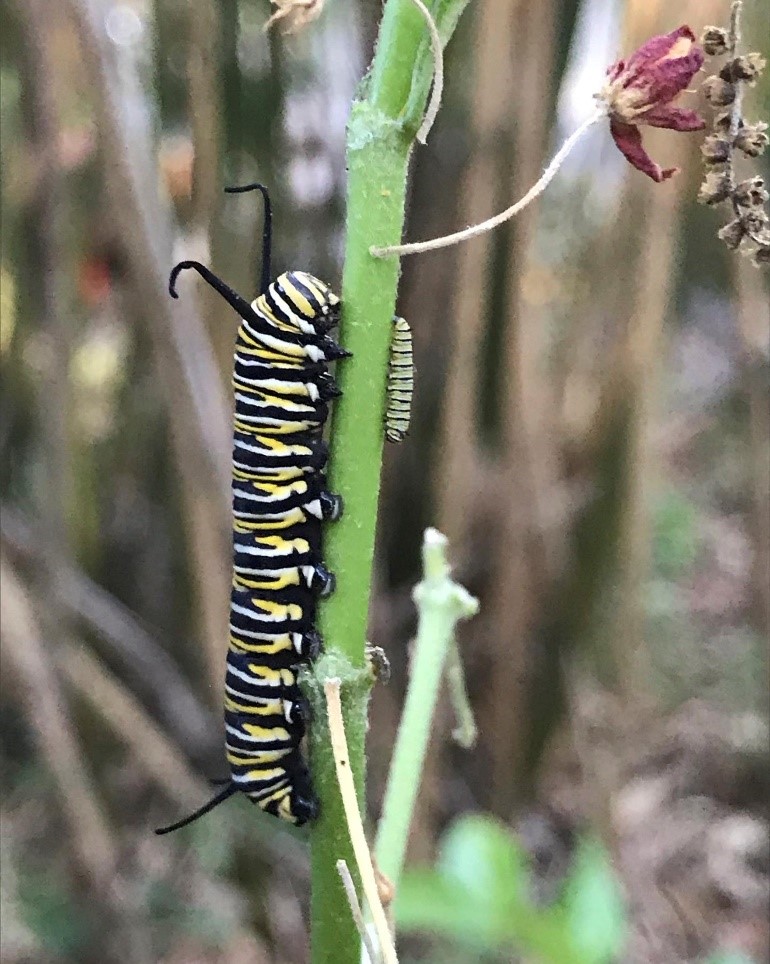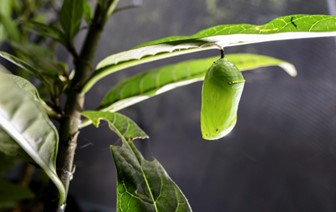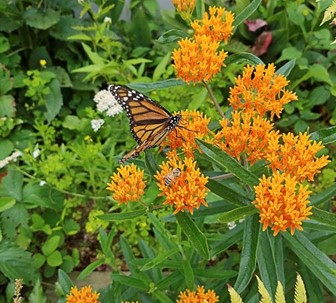December 2023 Milkweed and Monarch Butterflies
Truly one of the most fascinating and unique plants in the plant world. It is deadly to some insect species and on the other hand absolutely necessary to other species of insects. Born on the wind with their feathered seeds they can spread for large distances. With its hundreds of different variants being found all over the world, except in Antarctica, it has a large variety of quite complex and beautiful flowers.
Originally known by native Americans by many names: o-wah-kwenstah, waxca-xca, pannuim’pale, and many other names it was well known. It has some medicinal value and was used by native Americans and early settlers as a food source (if cooked properly). With more than 500 species the Asclepias genus is a part of the dogbane family. They may grow low to the ground or 12 or more feet in height. The milky sap has been used to make poison tipped arrows, experimental cancer drugs. It is a source of medicines, hallucinatory drugs, food, fiber, and even rubber.
BUT, far away when we hear the name milkweed we associate it with the beautiful Monarch butterfly which requires milkweed as an obligatory food.

Figure 1: Monarch Caterpillar

Figure 2: Monarch Chrysalis

Figure 3: Monarch butterfly with milkweed
So, let’s look at this ubiquitous plant and what we can do with it in our garden? BTW – We will primarily, in this article, look at the Milkweed plant (Ascelepias …). and will address the monarch butterfly in a future article.
The plant can be purchased at local nurseries in the early spring, but you might be able to find seeds online or from someone locally. If you plant from seeds do so in late fall but keep it inside until the chances of frost have passed. It is extremely easy to grow and readily self-seeds itself in the fall. It is best to plant in full sun with good drainage and do not overwater as it will die from fungus infection. I use a soaker hose, cover it with mulch, and water about an hour every few days depending on the rain we have. The soil type is very forgiving, and they can grow almost anywhere with a soil pH of 5-7. Be careful not to fertilize too much as this will result in underperformance. When you plant the seeds, you should be aware it is sometimes considered an invasive species but in most places it is not. It is sometimes used to help control erosion as it spreads vis its root system. Also, when you plant it be aware that it does have a taproot that may make it difficult to remove, so plant it in an area where it can grow for a few years where you do not have to remove it each year.
I have found that simply place a seed in a small pot, keep it damp and maybe on a grow mat and it will do quite well. Typically, I get an 85%-90% germination rate. When the chance of frost is gone, and the seedlings are a few inches in height move them outside to your flower bed spacing them about 6-12 inches apart. They will start blooming in early summer and will flower until at least November. Once they start growing you can cut off shoots from the bottom, root them in water, and plant in your flower bed. You can also propagate them from cuttings once they have started growing in the summer. Simply cut the stem, remove the lower leaves, and use a growth hormone on the bottom of the cut stem. Plant the treated stem in a good potting soil with some use perlite and peat moss. Keep the soil moist and in the shade and in a few weeks, you will have rooted plants to plant in the yard.
It is probably not a plant that you would want to plant in a formal garden but then it does depend on which species you grow. The height of milkweed will range from two to six feet in height. They are typically long stemmed and not bushy plants. They will spread from the seed pods and will spread quite easily from the seeds which have a silk fine “fuzz” which are easily scattered by the wind. They will overwinter in our area, but I would cut them back in the winter and cover them with straw and they will come back in the spring. You must be aware that they spread not only via seed but rhizomes. So be careful where you plant them as they easily spread.
In working with them be careful as milkweed is toxic so wear gloves and a long-sleeved shirt. Deadheading the spent flowers will result in new buds. At this point you will have to decide – do I want monarchs feeding on the plants or not? If you are planting for the plant and flowers you will have to occasionally spray with a general-purpose insecticide. The primary pest is the monarch caterpillar and it can do serious damage in just a few days. So look at your plants every week or two. There are other pests that will eat the milkweed plant so keep an eye on them.
What types of milkweeds are easily grown here are:
- Common milkweed (A. syriaca)
- Swamp milkweed (A. incarnata)
- Butterfly weed (A. tuberosa)
Other Information
Have JUST found this very fascinating web site which has a great podcast on Milkweed by Eric Lee-Mader . You can listen to it on your desktop, laptop, etc. He is also the author of the book The Milkweed Lands: An Epic Story of One Plant: Its Nature and Ecology listed below.
Where can I get milkweed seeds online. Both URLs will give you a variety of sources to get a variety of milkweed seeds and/or plants.
- https://monarchjointventure.org/get-involved/create-habitat-for-monarchs
- https://www.xerces.org/milkweed/milkweed-seed-finder
Go to Amazon and search for milkweed seeds – They have a large selection. You will only need a small packet of seeds and many of the source’s ship six, or so, varieties of milkweed per order. Do not waste your money on plants as they are quite expensive relative to the seeds.
There are a few nurseries in the local area that will sell milkweed plants at reasonable prices. Based on last year’s prices a single plant will range from $3.50 to $10.00. Myself, I simply get the seeds from last year’s plants `and plant my own.
There are a couple of books on Milkweed and Monarchs you might want to look up. Again – guess where to go – Amazon:
- Monarchs and Milkweed: A Migrating Butterfly, a Poisonous Plant, and Their Remarkable Story of Coevolution Hardcover – March 28, 2017
- The Milkweed Lands: An Epic Story of One Plant: Its Nature and Ecology Hardcover – September 26, 2023
External references for pictures and other information
- https://extension.psu.edu/monarchs-and-milkweed
- https://www.floridamuseum.ufl.edu/museum-blog/mother-of-monarchs-unexpectedly-rearing-22-caterpillars/
- Some of this information was gleaned from the a column by the garden columnist for “The New York Times, Margaret Roach and the referenced podcast is from her web site: https://awaytogarden.com/